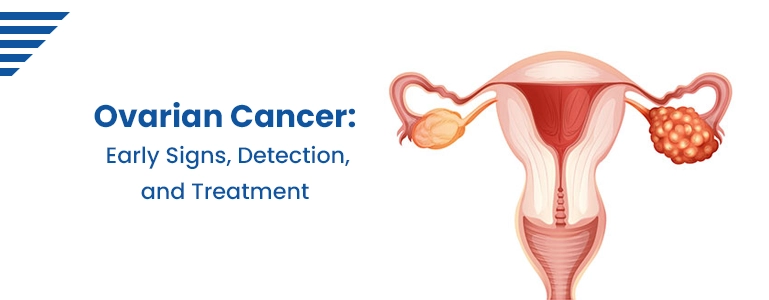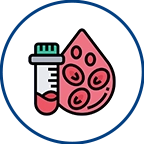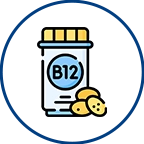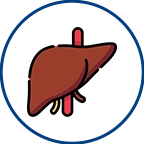Ovarian Cancer: Early Signs, Detection, and Treatment

Due to its secretive character in the early stages, ovarian cancer is a tough foe and frequently referred to as the "silent killer". It ranks as one of the most common and deadliest gynecological cancers among women worldwide. However, with increased awareness and advances in medical science, early detection and effective treatment options have improved the prognosis for those affected. In this blog, we will explore the early signs of ovarian cancer, methods of detection, and the latest treatment options available.
Early Signs and Symptoms
Ovarian cancer can be challenging early stages due to the fact that its symptoms frequently resemble those of less serious illnesses. However, recognizing the warning signs can lead to earlier detection and improved outcomes. Some of the early signs and symptoms of ovarian cancer include:
Persistent abdominal or pelvic pain: Frequent or continuous discomfort in the lower abdomen or pelvis may be an early indicator of ovarian cancer.
Bloating: Unexplained and persistent bloating, often accompanied by a feeling of fullness, can be a warning sign.
Difficulty eating or feeling full quickly: If you find yourself unable to finish meals or experiencing early satiety without an obvious reason, it's worth discussing with a healthcare provider.
Changes in bowel habits: Your bowel movements could vary as a result of ovarian cancer and could become constipated or diarrheal.
Frequent urination: An increased need to urinate, often accompanied by urgency, may be a symptom of ovarian cancer.
Unexplained weight loss: Unexpected weight loss that occurs suddenly and without cause may indicate ovarian cancer among other health problems.
Fatigue: Ongoing, unexplained fatigue can be associated with many illnesses, including ovarian cancer.
Home Sample Collection
It's important to note that these symptoms are non-specific, meaning they can occur for various reasons. However, if you experience any of these signs persistently, it's crucial to consult a healthcare professional for a proper evaluation.
Detection Methods
Early detection is vital for successful ovarian cancer treatment. Various methods and tests are available for detecting ovarian cancer:
Pelvic Examination: During a pelvic exam, a healthcare provider may feel for abnormalities in the ovaries or surrounding tissues. However, this method is not always effective at detecting early-stage ovarian cancer.
Transvaginal Ultrasound (TVUS): This imaging technique uses a probe inserted into the vagina to create images of the ovaries. TVUS can help identify ovarian tumors, but it may not distinguish between benign and malignant masses.
CA-125 Blood Test: CA-125 is a protein that can be elevated in the blood of some ovarian cancer patients. However, it is not a definitive diagnostic tool as other conditions can also cause elevated CA-125 levels.
Pelvic CT or MRI: These imaging techniques can provide detailed images of the pelvic area and may be used to confirm the presence of ovarian tumors and assess their characteristics.
Biopsy: In a biopsy, a small tissue sample is taken from the ovary or another questionable location and examined under a microscope. It is the most accurate method of ovarian cancer diagnosis.
It's important to remember that no single test can guarantee the presence or absence of ovarian cancer. A combination of these methods and consultation with a gynecologic oncologist is often necessary for an accurate diagnosis.
Treatment Options
Treatment for ovarian cancer typically involves surgery and may be followed by chemotherapy or targeted therapy. The stage and kind of the patient's ovarian cancer, their general health, and their treatment preferences all influence the choice of treatment. The main types of treatment are as follows:
Surgery: Surgical intervention is often the first step in treating ovarian cancer. The extent of surgery depends on the stage and characteristics of the cancer. It may involve removing the ovaries, fallopian tubes, uterus, and nearby lymph nodes. In some cases, a debulking procedure is performed to remove as much of the tumor as possible.
Chemotherapy: Following surgery, chemotherapy is frequently used to eradicate any cancer cells that may still be present. It may also be used as the primary treatment for advanced-stage ovarian cancer. Chemotherapy drugs are often given intravenously and can have side effects, which can be managed with medications and lifestyle adjustments.
Targeted Therapy: Some ovarian cancers respond to targeted therapies that specifically target cancer cells or the molecules that support their growth. These therapies are often used in combination with chemotherapy.
Immunotherapy: Immunotherapy is an emerging treatment option for ovarian cancer that harnesses the body's immune system to target and destroy cancer cells.
Hormone Therapy: Certain kinds of ovarian cancer may occasionally be treated with hormone treatment to limit their growth.
Conclusion
Ovarian cancer is a formidable adversary, but early detection and advances in treatment options have improved the outlook for those affected. Recognizing the early signs and symptoms is crucial for early detection, and regular check-ups with a healthcare provider are essential, particularly for individuals with risk factors such as a family history of ovarian cancer.
Frequently Asked Questions
1. What are the early signs of ovarian cancer?
Ovarian cancer's early warning symptoms can be imperceptible and simple to miss. They include exhaustion, changes in bowel habits, frequent urination, frequent urination, unexplained weight loss, and persistent stomach or pelvic pain. If you frequently have these symptoms, seek assessment from a healthcare professional.
2. Is there a screening test for ovarian cancer like the mammogram for breast cancer?
There is no single screening test for ovarian cancer as effective as a mammogram for breast cancer. While transvaginal ultrasound (TVUS) and the CA-125 blood test are occasionally used for screening, they have drawbacks and can result in false positives or false negatives.Currently, no routine screening is recommended for the general population, and screening is typically reserved for individuals at high risk due to family history or genetic mutations.
3. How is ovarian cancer diagnosed?
Ovarian cancer is typically diagnosed through a combination of methods. These may include a pelvic examination, transvaginal ultrasound (TVUS), CA-125 blood test, pelvic CT or MRI, and ultimately, a biopsy of suspicious tissue to confirm the presence of cancer.
4. What are the stages of ovarian cancer, and how do they affect treatment?
Ovarian cancer is staged from I to IV, with higher stages indicating more advanced disease. The stage influences the treatment plan. Stage I and II cancers are usually treated with surgery to remove the tumor, while stage III and IV cancers often require surgery followed by chemotherapy. The specific treatment plan is determined by the cancer's stage, type, and the patient's overall health.
5. Are there any risk factors for ovarian cancer?
Ovarian cancer risk factors include age (most cases occur in women over 50), a family history of the disease, specific genetic mutations (such as BRCA1 and BRCA2), never having given birth, beginning menstruation early or entering menopause late, and not having been pregnant.
6. What are the latest advances in ovarian cancer treatment?
Recent advances in ovarian cancer treatment include the development of targeted therapies and immunotherapies that can better target cancer cells while minimizing damage to healthy tissue. Additionally, there have been advancements in surgical techniques, including minimally invasive procedures and robotic-assisted surgery, which can reduce recovery times and complications.
7. Can ovarian cancer be prevented?
While ovarian cancer cannot be entirely prevented, certain steps may reduce the risk, such as having a healthy lifestyle, including a balanced diet, regular exercise, and not smoking. For individuals with a strong family history or known genetic mutations, prophylactic surgery (e.g., removal of the ovaries) may be an option to reduce the risk.
8. What should I do if I suspect I have ovarian cancer or have a family history of the disease?
If you have concerning symptoms or a family history of ovarian cancer, it's essential to consult a healthcare provider. They can perform the necessary tests and provide guidance on the best course of action, which may include genetic counseling and testing for certain high-risk gene mutations.
9. Are there support resources available for ovarian cancer patients and their families?
Yes, many organizations and support groups provide information, emotional support, and resources for individuals and families affected by ovarian cancer. These organizations can offer guidance on treatment options, coping strategies, and connecting with others who have faced similar challenges.
10. What is the outlook for ovarian cancer patients today?
The outlook for ovarian cancer patients has improved over the years, particularly when the disease is diagnosed and treated in its early stages. Advances in treatment options and supportive care have led to better survival rates and an improved quality of life for many patients. However, outcomes still vary depending on the stage and type of cancer, emphasizing the importance of early detection and personalized treatment plans.
Book Your Slot
Our Locations Near You in Hyderabad
3KM from Banjara Hills
1.9KM from Yusufguda
3KM from Madhura Nagar
5KM from Shaikpet
Profiles
- Cardiac Risk Profile
- Pituitary marker Profile
- Rheumatoid Arthritis Profile
- Dengue Fever Panel
- Lung Cancer Panel 1 Complete Molecular
- Gastroenteritis Screening Panel
- Thyroid Profile (T3,T4,TSH), Serum
- Pancreatic Marker Profile
- STD profile
- Androgen Profile
- Lipid Profile, Serum
- Pancreatic(acute)Profile
- PCOD Profile
Radiology
Pathology Tests
- Glucose Fasting (FBS),Sodium Fluoride Plasma
- Creatinine, Serum
- Glycosylated Hemoglobin (HbA1C)
- Vitamin B12 (Cyanocobalamin), Serum
- Thyroid Stimulating Hormone (TSH) Ultrasensitive, Serum
- Complete Urine Examination (CUE), Urine
- Liver Function Test (LFT),Serum
- Dengue (IgG & IgM), Serum
- Dengue Antigen (Ns1) Rapid, Serum
- C-Reactive Protein (CRP), Serum
- Widal (Slide Method), Serum
- Total IgE, Serum




